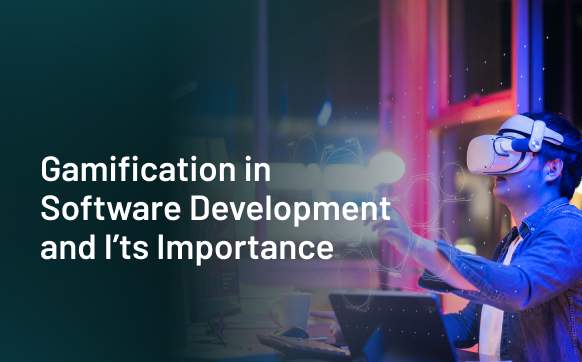
Gamification In Software Development and Its Importance
The context of ‘gamification’ has been popular for a few years. Gamification is the consideration of game-based elements in a given scenario. Its primary intent is to make things more exciting and engaging. When software uses gamification, it tends to induce some behavior within users, improving the motivation factor in a specific task.
Gamification has been prominent in different sectors, such as learning and education. Particularly in the education sector, gamification is used to increase learner engagement. Hence, it improves their performance. Given its significance in user engagement, software developers have made it a point to incorporate these elements into their products.
Moreover, business-oriented websites acknowledge the utility of gamification in improving user experience. Although there is a lot of scope for gamification in software development, it is yet to be explored. This blog focuses on the importance of gamification in software development.
A Quick Overview of Gamification
The story of gamification begins with our innate human desire to play and compete. Games have been a crucial part of human culture since the early years, from traditional board games to physical challenges. However, the concept of gamification as we know it today emerged more recently.
Nick Pelling, a British computer programmer, introduced the term “gamification” in 2002. He used it to describe the usage of game principles and elements. However, you can track the basis of gamification further.
Gamification continues to evolve rapidly in the digital landscape. This growth is due to technological advancements and our growing understanding of human psychology. With augmented reality, virtual reality, and artificial intelligence, the scope for creating immersive and personalized gamified experiences is expanding even in software development.
What are the Objectives of Gamification in Software Development?
Gamification in software development brings in a new arena of user engagement. The primary objectives of gamification are given as follows.
- To captivate and engage users by leveraging game-like features such as points, badges, leaderboards, and challenges.
It makes the software more interactive and enjoyable, encouraging users to spend more time using the application or software system.
- To tap into intrinsic and extrinsic motivations driving user behavior.
By providing rewards and a sense of accomplishment, gamification motivates users to achieve specific goals, complete tasks, or adopt desired behaviors.
- To encourage users to adopt new behaviors or embrace actions.
It utilizes game mechanics like challenges or quests.
- To gather valuable data about user behavior and interactions.
The collected data provides insights into user preferences. This allows for improvements, enabling software developers to refine their products and optimize user experiences.
- To foster teamwork, collaboration, and healthy competition among users.
What are the Basic Elements of Gamification
The key intent is to build an immersive experience for users. On this note, the essential elements are as follows.
- Level-based Rewards
Gamification incorporates a points system. Users participate in gaming activities to earn points for completing tasks, achieving milestones, or demonstrating certain behaviors. These points can be accumulated and used to unlock rewards, such as badges, virtual goods, or access to new features. The sense of progression and tips encourage users to continue using the software.
- Achievements
Achievements or badges represent virtual honors that users can earn by achieving notable milestones in the software. These visual representations of accomplishment provide a sense of recognition and pride, encouraging users to explore and engage with the software further.
- Leaderboards Illustration
Leaderboards display the rankings of users based on their performance, points, or other relevant metrics. They introduce an element of competition and social comparison, driving users to strive for higher positions or to surpass their peers. Leaderboards can be either global or limited to specific groups or communities.
Get the gamification feature embedded in your software for a higher conversion rate.
- Challenges and Quizzes
Quizzes and challenges present users with specific tasks. These can be time-limited or ongoing and may vary in terms of difficulty. Users are asked to complete quizzes and earn rewards or gain access to new features, encouraging continued exploration.
- Sense of Collaboration
Gamification in software development often fosters social interaction among users. It includes features like forums or chat systems, allowing users to collaborate on tasks. Through integrating social elements, users can share their achievements, or collaborate to achieve common goals, improving the experience.
- Progress Tracking Functionality
Providing users with feedback on their progress is crucial in gamified software. Progress tracking features like progress bars, visual indicators, or analytics dashboards are relevant. It allows users to see their advancement and performance.
Instances of Gamification in Software Development
You can find several instances of gamification in software development regardless of the industry you serve. Let’s take examples from some sectors.
- Education
Showcasing badges and rewards on the software motivates learners to pass all the stages. This instills a sense of competitiveness within them. Given the growth of digital learning in the US, businesses look forward to embedding gamification in their software.
- Retail
A custom software development company incorporates game-based features like loyalty programs and quizzes, offering engaging digital experiences.
Software meant for the retail industry also uses other engagement techniques and incentives. Hence, gamification in retail is a potential parameter to drive business growth.
- Hotel and Hospitality
Gamified-based software is an excellent way to establish user engagement.
You may have noticed spin wheels placed on the software interface. It motivates users to interact and win exciting offers. Although the feature is embedded in software development companies, consider it a smart marketing strategy.
To Conclude
Game-based elements instill a sense of playfulness in people of every age group. Incorporating such elements in software is quite a thoughtful strategy on the developer’s side. Placing it correctly and resonating the element with the brand narrative is complex. You cannot just randomly add a game-based lament. You have to understand the needs of your target audience and then proceed.
By collaborating with the best software development company, you can make the right move in targeting your audience. If you haven’t added this functionality, you may miss out on some effective marketing tactics.












